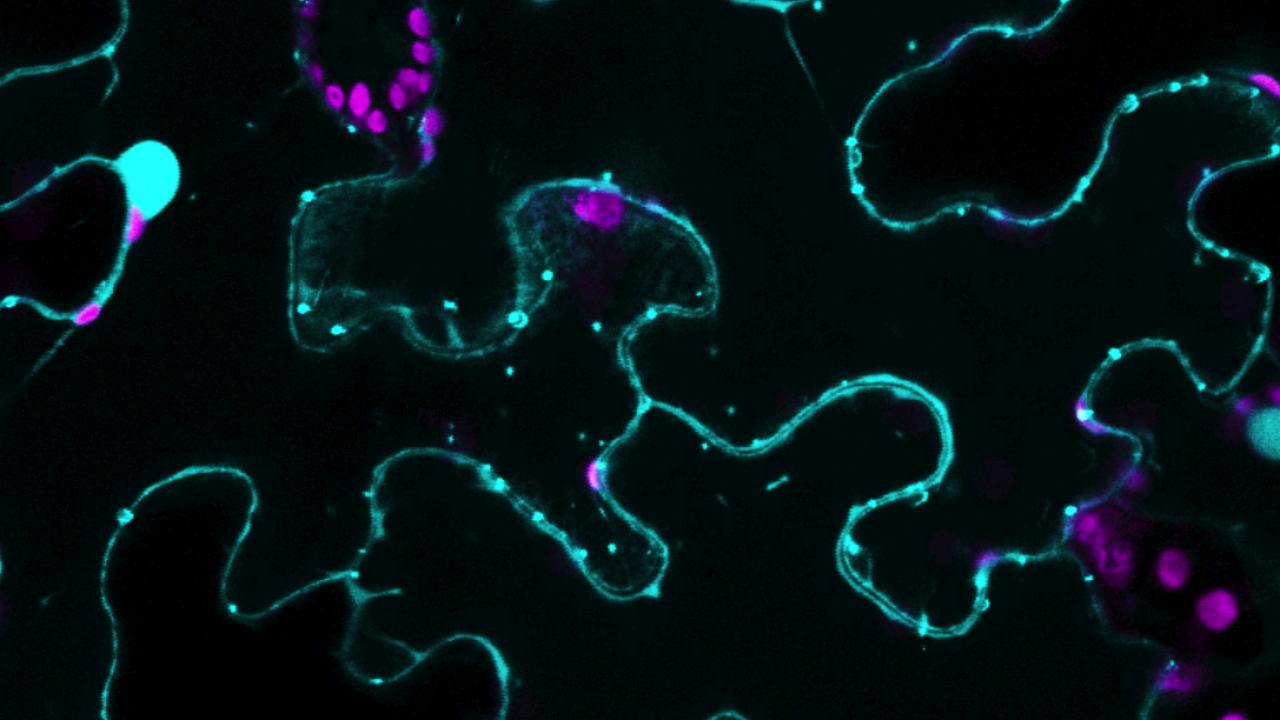
Investigating the Molecular Defense Tactics of Plants
Plants deploy an arsenal of chemical strategies to survive in their environments. Dangers are aplenty, and not just from hungry herbivores. Bacteria, fungi and viruses pose threats too, though the battle against these invaders occurs at the molecular level.
In a study appearing in Cell Host & Microbe, UC Davis graduate student Neeraj Lal, Professors Savithramma Dinesh-Kumar and Andrew J. Fisher and their colleagues reveal the versatility of plants’ molecular infantry. The findings provide a strategic map revealing how plants allocate resources and have the potential to help bolster crop immune systems and improve their development and growth.
Mounting a successful defense
When invaders breach a plant’s first line of defenses, a microscopic smoke signal is set off, rallying plant resources from other activities to respond to the attack.
“Mounting a successful immune response to defend against pathogens is metabolically expensive and is often initiated at the cost of normal developmental processes,” said Lal, a Biochemistry, Molecular, Cellular and Developmental Biology graduate student. “Presence of a pathogen means shutting down growth pathways and allocating resources toward defending against pathogens and vice versa.”
For decades, scientists thought certain plant defense hormones were isolated in their activity. They had their specialties, like the branches of the military, or so the thinking went. When bacteria invaders were at the gate, plants, scientists thought, produced salicylic acid to combat the invaders. When invaders hailed from the fungi kingdom, plants used jasmonic acid for defense.
But the boundaries aren’t as clear-cut as previously thought, according to the new research. The actual response is more like a joint military operation.
“Our research revealed that jasmonic acid also seems to play a major role in bacterial resistance,” said Dinesh-Kumar, a plant biology professor. “But how we got to that point was all based on working at the structural and molecular level.”
Dinesh-Kumar and colleagues initially set out to define the molecular structure of a plant enzyme called BIK1, which activates defense responses when a bacteria invasion is recognized on a plant’s cell surface. Previous research indicated BIK1 was important to plant immunity but its structure and involvement in defense hormone regulation hadn’t been mapped.
The researchers discovered BIK1’s presence not only in the plasma membrane of Arabidopsis thaliana, a popular plant biology model organism, but also in the cells’ nucleus. Immune responses primarily occur in the nucleus, so finding BIK1 there further emphasizes the important role the molecule plays in plant immunity.
Command and control centers
BIK1 is a member of a large family of enzymes that governs many actions throughout Arabidopsis thaliana’s lifecycle. Lal likened it to a “command and control center” that governs defense and growth processes, gathering intelligence and responding to the surrounding environment.
“Mostly, these signals are present simultaneously, and yet BIK1 somehow decides the most appropriate response,” said Lal. “Sometimes these input signals can have opposite outcomes.”
When Lal and the team defined BIK1’s structure, they noted a unique loop that wasn’t present in other molecules related to BIK1. Further investigation revealed that previously unknown immune receptors dotted the sites in the loop. Much like perimeter guards, these sites—when they sense bacterial or fungal invaders—sound the alarm to deploy salicylic and jasmonic acid joint strike forces.
Approaching biology from all angles
The study was funded by the UC Davis Research Investments in the Sciences and Engineering program and the National Science Foundation. Additional authors include Ugrappa Nagalakshmi, Nicholas Hurlburt, Rosalav Flores, Aurelie Bak, Paye Sone, Xiyu Ma, Gaoyuan Song, Justin Walley, Libo Shan, Ping He and Clare Casteel.
“Genetics, structural biology, biochemistry, molecular biology, a combination of fields is what made this possible,” Dinesh-Kumar said. “These days in biology, you have to take multiple approaches to answer a specific question.”
Dinesh-Kumar and Lal said future research could specifically focus on BIK1’s involvement in plant growth and development. Further defining BIK1’s role in the growth-defense dichotomy of plants might help scientists understand the molecular nature of developmental disorders.
“Tilting the balance in favor of growth could be a useful trick to increase crop yields,” Lal said.
